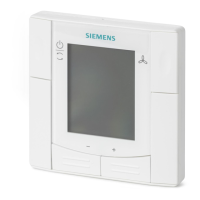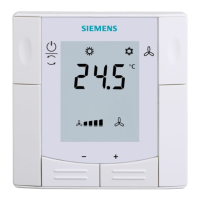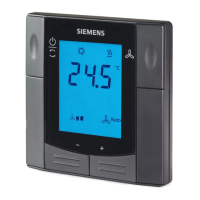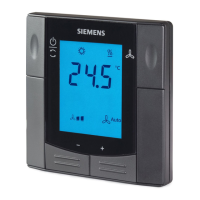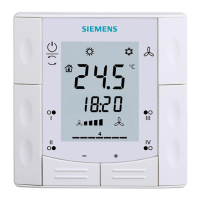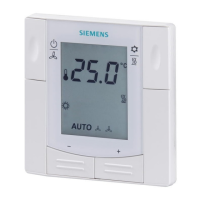The thermostat's control parameters can be set to ensure optimum performance of
the entire system (see basic documentation P3171).
The parameters can be adjusted using
− Local HMI
− Synco ACS
− ETS
• The control sequence may need to be set via parameter P01 depending on the
application. The factory setting for the 2-pipe application is "Cooling only"; and
"Heating and Cooling" for the 4-pipe application.
• When the thermostat is used with a compressor, adjust the minimum output on-
time (parameter P48) and off-time (parameter P49) for Y11/Y21 to avoid
damaging the compressor or shortening its life due to frequent switching.
• Recalibrate the temperature sensor if the room temperature displayed on the
thermostat does not match the room temperature measured (after min. 1 hour of
operation). To do this, change parameter P05.
• We recommend to review the setpoints and setpoint ranges (parameters
P08…P12) and change them as needed to achieve maximum comfort and save
energy.
The programming mode helps identify the thermostat in the KNX network during
commissioning.
Press buttons "operating mode"
and "+" simultaneously for 6 sec to activate
programming mode, which is indicated on the display with "PrO
g
".
Programming mode remains active until thermostat identification is complete.
Assign device address (P81) via HMI, ACS or ETS.
With device address set to 255, the communication is deactivated (no exchange of
process data).
Use ETS to assign the KNX group addresses of the RDF communication objects.
RDF301.50 and RDF301.50H have 2 switching groups with a pair of buttons each,
which must be configured via ETS. The switching groups only work on S-mode.
Each device has a unique KNX serial number inside the front panel. An additional
sticker with the same KNX serial number is enclosed in the packaging box. This
sticker is intended for installers for documentation purposes.
Disposal
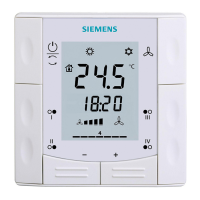
